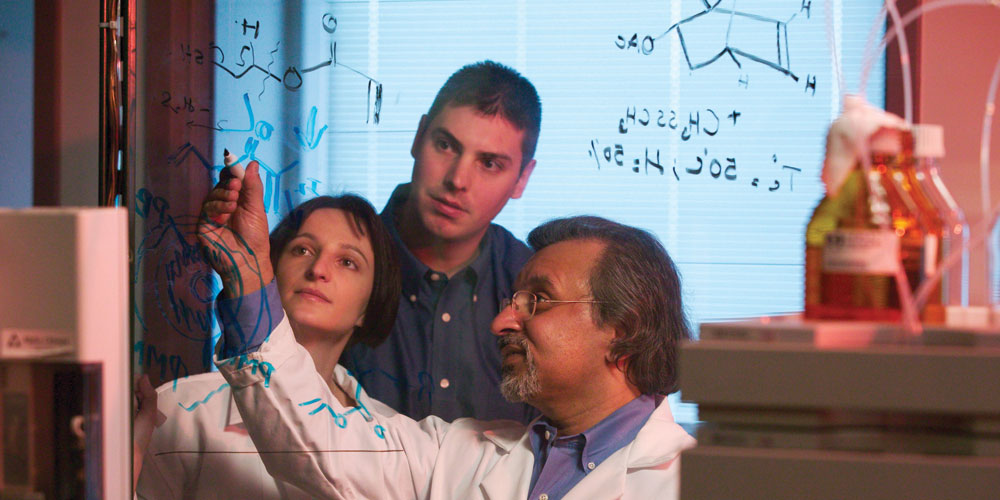
For chemicals manufacturer Arkema Inc., customer and regulatory requirements are opportunities for product change and improvement.
Arkema Inc., headquartered in King of Prussia, PA, may be a company that most Army AL&T readers have never heard of. But it’s also likely that most readers have come in contact with the company’s products, which can be found in a wide variety of industries, including building and construction, agriculture, automotive, water purification, household and industrial cleaning, dental hygiene, batteries and energy storage, and solar energy. Among those products are “chemical intermediates,” substances fundamental to chemical processes, coatings or materials in coatings, and additives that enable a component to be manufactured or improve the final product’s cost and performance.
Arkema might not make the sheet of glass in a window, but it very well could have made the coating on the glass that helps it keep heat inside or outside a building. The company might not make the fuel line in the family car, but might make the component that helps the fuel line meet federal regulations. It might not make the metal that covers the Petronas Towers in Kuala Lumpur, Malaysia, the tallest twin towers in the world, but it most certainly did make the Kynar coating that keeps the buildings’ metal cladding colorfast and resistant to weather, sun, chemicals and pollutants.
According to the company, Arkema’s business revolves around “innovation platforms” that it believes can play a role in resolving future challenges of societal importance, including access to drinking water, affordable alternative energy, energy storage and sustainability. These platforms include photovoltaics and wind, renewables, energy efficiency and water management.
We reached out to Arkema because, of all the industries out there, a major player in the heavily regulated chemical industry might offer Army AL&T readers insight into the ways that industry develops its own requirements—or addresses government-mandated requirements. And the materials Arkema makes are just plain fascinating.
Probably the Arkema brand best known to the general public in the United States is Plexiglas. Another product, well-known to those in the coatings (e.g., paint), construction and building industries, is Kynar, which is an exceptionally durable, first-of-its-kind polyvinylidene fluoride (PVDF) coating that’s been around for 50 years. In fact, the venerable, trademarked Kynar is so well-known in the building industry that it is often, although wholly inaccurately, used as a synonym for PVDF coatings in general. Plexiglas and Kynar are registered trademarks of Arkema Inc.
For Dr. Ryan Dirkx, vice president of research and development (R&D) at Arkema Inc., Kynar and other PVDF coatings are the reason “you don’t ever see anybody out repainting a skyscraper. That’s because it’s once and done. The metal is actually coated back in the factory. They bend it into the shapes they need to build the skyscraper, and it’s never painted again.”
A veteran of more than 20 years at Arkema and its predecessor companies, Dirkx is responsible for R&D activity in North America, management of the R&D Center in King of Prussia and coordination with the global R&D activities of the parent company, Arkema, headquartered in Paris. He has directed global R&D organizations for several Arkema businesses, most recently, those within the Performance Polymers and PMMA (Altuglas) Divisions. (PMMA is poly(methyl methacrylate), more commonly known as acrylic “glass.”) He is a past chair of the Industrial Research Institute and past co-chair of the Board on Chemical Sciences and Technology, part of the National Academies.
Dirkx earned a B.S. in ceramic engineering from the New York State College of Ceramics at Alfred University and studied materials science at Pennsylvania State University, where he bypassed an M.S. and went straight to a Ph.D. in solid state science.
Army AL&T: A lot of our readers may not be familiar with your company, but it’s quite likely that products you make are right in their neighborhoods, homes or offices. Kynar comes to mind. Can you give us some examples of Arkema products that people may not be familiar with that they might see or use every day?
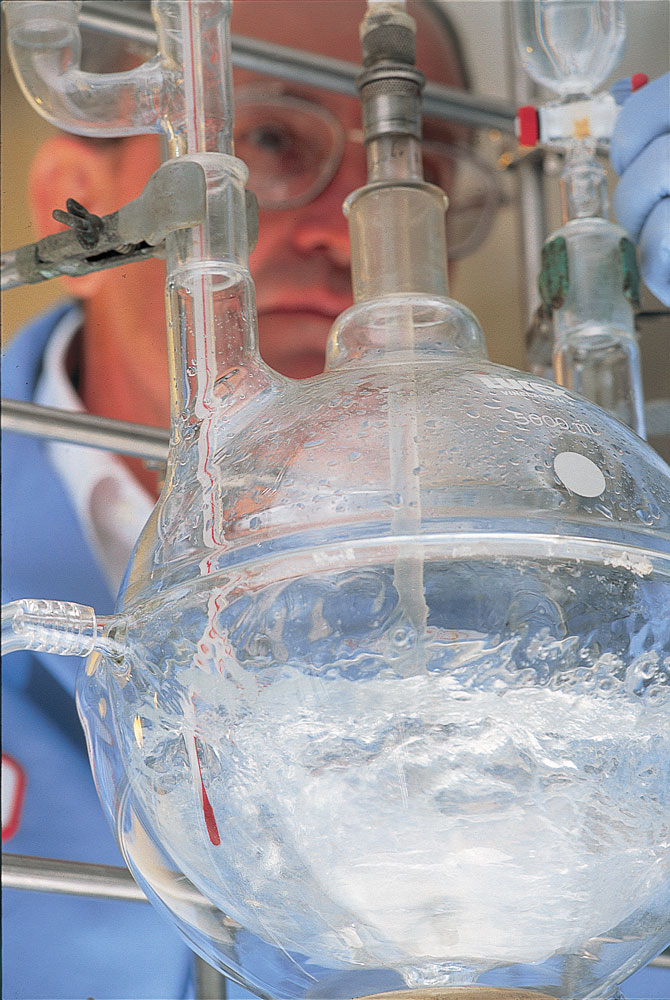
FROM RESEARCH TO PROGRESS Arkema’s laboratory experiments lead to advances in materials design and performance such as Kynar, a high-performing, durable coating that protects many of the world’s skyscrapers, and Plexiglas, perhaps Arkema’s best-known product. (Photos courtesy of Arkema Inc.)
Dirkx: Indeed, our products are not terribly visible unless someone points them out to you. Kynar is a good example of this. It is a high-performing paint that is used on most of the world’s skyscrapers. It lasts for decades, and that’s why you never see anyone painting these structures. Some other good examples would include Plexiglas taillights, hydrogen peroxide in cleaners, detergents and oral care products, and components in the lithium ion batteries found in your cellphones and photovoltaic solar panels. We have products that are made into nutrients for chicken feed and polymers that are used under the hood of your automobile.
Most often, if you buy an Arkema product, it’s going to be a component of the thing you buy. If you buy paint as a consumer, for example, there’s a lot of stuff in a gallon of paint. The resin that holds it together is an important part of the final properties that you get. In addition, the paint’s got a solvent, which today is largely water; it’s got pigments to give you the color; it’s got opacifiers and all kinds of things to give you the gloss that you want—and then a whole bunch of chemistry to keep it stable on the store shelf. So, we’re only a component in there. We’re a very important component because we are—think of it as the glue that holds the whole thing together. And that’s why it’s important that we have the formulation knowledge and capabilities in-house.
Generically, what I believe strongly in and what we more or less have done across the board in Arkema R&D is that our research goes downstream of where our product is. So if I’m developing chemistry to sell to a coating company, we have the ability to formulate coatings, make them and test their performance here. Another example is a fuel line. At the end of the day, we’re not going to make the fuel line, but I find it very important that we’re able to actually extrude complicated, multilayer tubing and test its properties in order to approach our tubing customers with formulations and processing conditions. We want to know as much about how our products will perform in the application as our customers—even more, if possible. So if they have a failure—I think this would be interesting for the Army, actually—we find it’s very important to have fully integrated R&D capability. If there’s a failure in a test or qualification, we want to be able to have an answer for that, to be able to say, “Well, it probably failed because the process conditions were too high or too low, or too this or that.”
We’ve got reams of data. You can imagine for things like skyscrapers, you need to have long-term weathering, samples sitting out in the sun in various regions in the world for decades in order to demonstrate capillary tension on the weatherability of this stuff.
Army AL&T: Kynar is 50 years old and by all accounts a great product. Can you tell us anything about its development that would give us insight into how the original requirements might have evolved over the years? Or have they?
Dirkx: This may not be the best example for this question, in that it is often considered the benchmark in its applications and competitive products are trying to meet the performance targets set by Kynar. That being said, there are some requirements that have driven product changes over the years. One example would be the local VOC [volatile organic compounds] requirements that drove us to develop solutions that allowed our customers to meet the more restrictive regulations.
Army AL&T: That must be tough to do.
Dirkx: What’s hard to do is to make the change. A number of your questions are about changing requirements. It’s hard when a customer has 30 years experience with a product—remember we have those test panels—they all have them, too, out in the sun. So when we come and want to make a change, they want to have some confidence that they’re not going to sacrifice anything on the longevity. Yeah, it’s difficult.
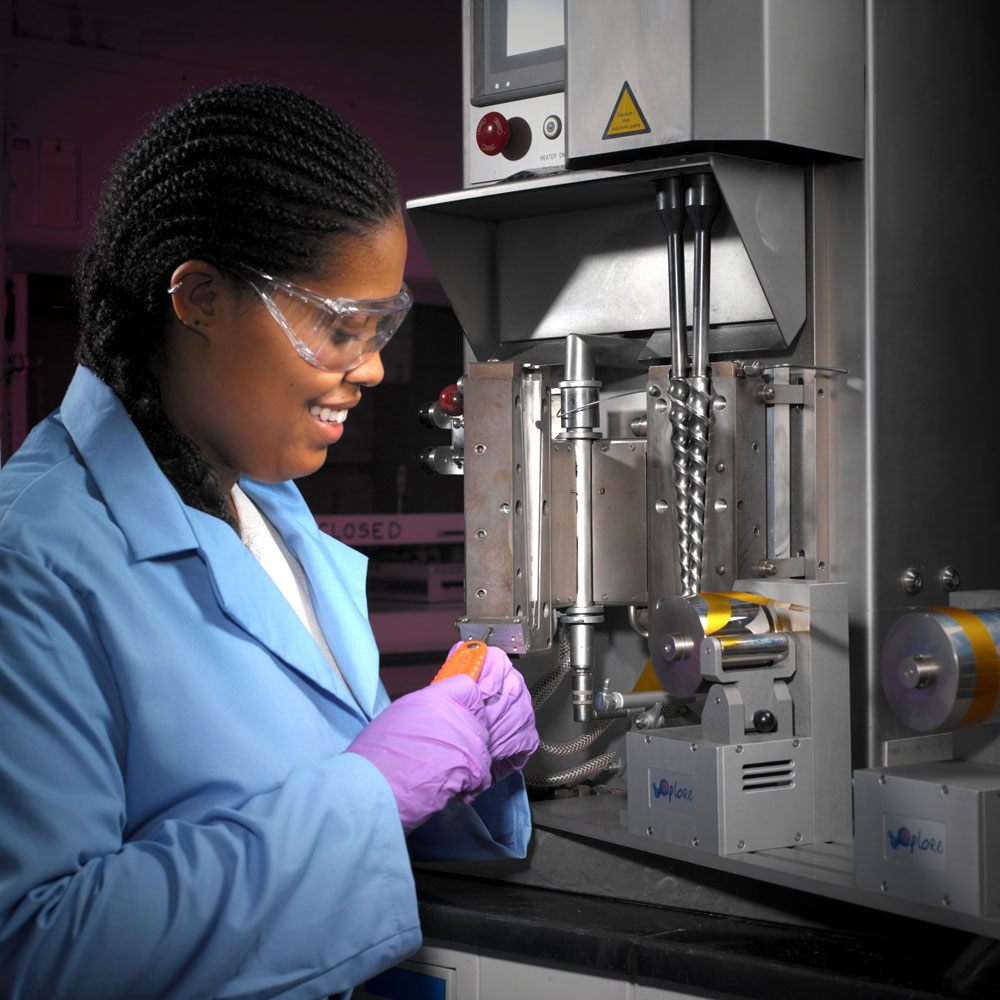
ASSESSING CAPACITIES A technician uses a micro-extruder to evaluate small quantities of experimental polymers. Arkema’s business revolves around “innovation platforms,” including photovoltaics and wind, renewables, energy efficiency and water management. In order to ensure that it meets its customers’ requirements, Arkema maintains the knowledge and capability to formulate polymers in-house.
Army AL&T: When you talk about these local VOC requirements, do you see regulation coming down the line and say, “Okay we’ve got to prepare for this, we’ve got to be able to change the formulation so that we can meet these regulatory requirements?” How does that work?
Dirkx: That’s a big question. There was a time, whether we’re talking about the consumer space or the industrial space, where all paints were solvent-borne. You remember probably painting rooms and the odors were quite strong, and what you’re smelling of course is the vaporization of the solvents. The industry, over a long period of time, has shifted more toward water-borne or water-based coatings.
And largely that was driven by regulatory requirements. So we could see that coming. And again, we’re not making paints, we’re making components in paints. But just the way I explained it to you a moment ago, that’s another important reason for us to have formulation capabilities, the same kind of capabilities our customer base has, in order to demonstrate that we could move our components—and by the way, this happened in baby steps. The first thing you can do is go to lesser amounts of solvent. You have a mixture of solids and liquids in a gallon of paint. The industry moved to what they call “higher solids.” So one of the ways you can meet the new regulations is to put in less solvent and more solids—more Kynar, more pigments, more other stuff, which is not only a change in chemistry on our side, but also a lot of reformulation. And then, of course, you must demonstrate that the performance isn’t compromised out in the field.
The next step was to go to water-based coatings. And again, now you’ve almost completely eliminated the solvents. There’s little bits of volatile organics that are left, but not much. And again it’s the same thing: We have to develop new chemistry, new formulations, and demonstrate that the finalized coatings, the properties, aren’t compromised in any way. So those are big changes that took a long time.
And we saw it coming, as [did] a lot of suppliers. We’re not alone. And we went through the process with our customers to help them meet the new regulations.
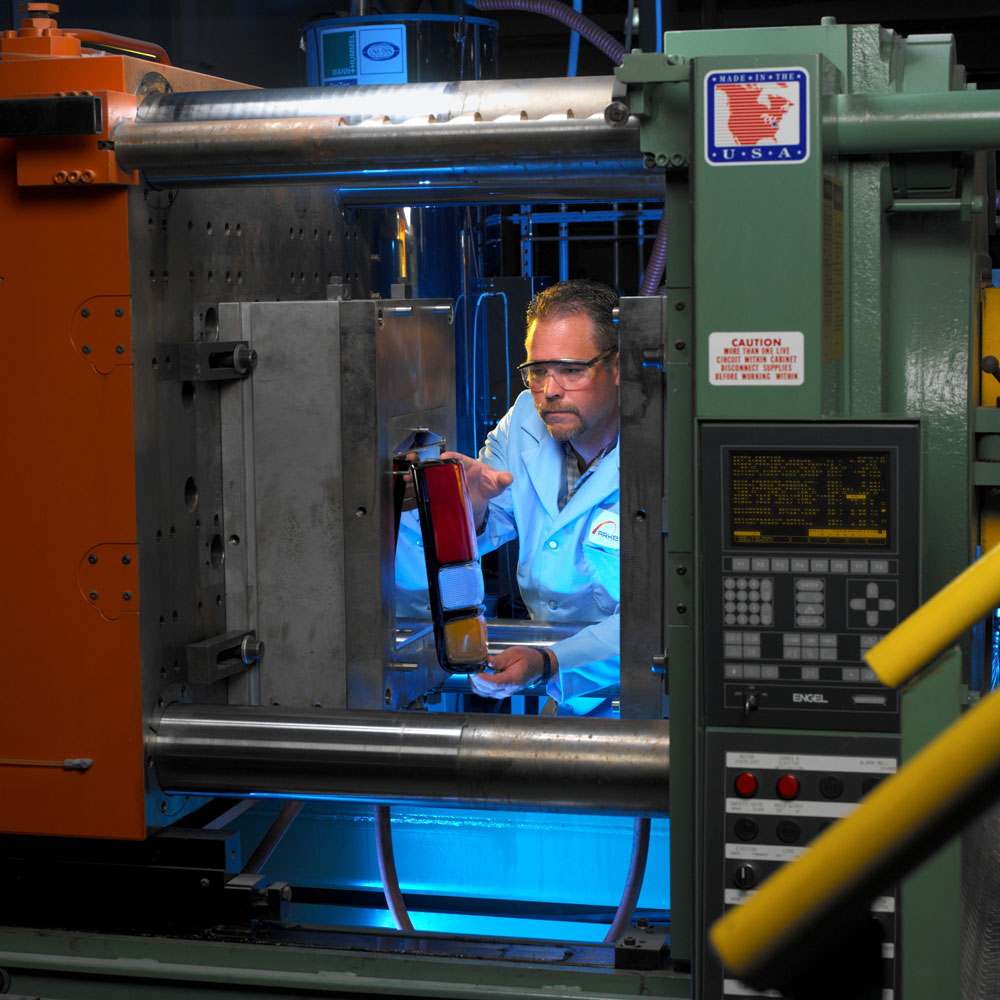
A REPEATING THE PROCESS A commercial-scale, 450-ton injection molding machine allows Arkema to duplicate the customer’s processing conditions and troubleshoot problems. For Dirkx, this capability is fundamental to the success of Arkema’s relationship to its customers along the supply chain.
Army AL&T: How does the process of developing chemicals or chemical compounds work? That is, when you see a need or a trend—such as nano, omniphobic and superomniphobic coatings that have so much promise—how do you go about establishing the requirements for developing future compounds?
Dirkx: I would say that for what we do, establishing the requirements comes a bit later. We often talk about identifying unmet needs and trying to differentiate those that are a real pain point for our customers or our customers’ customers versus those that would be a “nice to have” solution. With this unmet need in mind, we can then look at how we might develop a solution from the tools in our toolbox. With a potential solution in mind, the marketplace is again engaged in order to validate the need and to begin the discussion regarding requirements or specifications.
We think of those things as platforms, about some of the things you’re describing. So if I take nano as an example, sure, we’re doing stuff in the nano world, and we have for decades. What would happen that became kind of interesting over the last decade and a half or so is that first, our analytical tools have improved to the point where you can actually start to visualize some of this. So it made it real for people.
But to come back to your question, we can talk about something like block copolymers as an example.
Army AL&T: And what are those?
Dirkx: This is a hard one to describe. If you think of a polymer as a kind of a plate of spaghetti, it’s all these long chains of molecules represented by the noodles of spaghetti. The property of that material will be based on the chemistry of these long spaghetti noodles, how long they are and how they’re held together, the bonding in between. One of the options you have in making a polymer is to think of one of those noodles. It’s got two ends to it. One end is one chemistry and one end is another chemistry, and so we refer to those as blocks. So put a line in the middle of that thing. Half of it could be hydrophobic and the other half could be hydrophilic—water-loving and water-repelling. And you can marry those chemistries, again at a nano scale. Now the properties of that polymer that’s made up of all that plate of spaghetti has the combination of the two properties that I just gave you as an example.
The world knows about block copolymers, but my point was to use that as another example, like nano, of what we would consider a technical platform. Or I think I talked about it as a tool in our toolbox that we would use as a potential solution to a challenge in the marketplace or an opportunity in the marketplace. And we call them a number of things—core competencies, platforms—that define our skill set inside of Arkema, that we [use] to try to bring solutions to the marketplace.

PERFECT BEAM Kynar coating has been around for 50 years, and part of the durability of the brand as well as the coating itself is that technicians, such as this one, can measure its dimensions with laser precision so that when a skyscraper’s Kynar-coated metal cladding goes onto a building, it stays colorfast, and impervious to weather, sun, chemicals and pollutants.
Army AL&T: The chemical industry is heavily regulated, and Arkema is an international company. Do you take regulatory requirements into consideration when establishing requirements for your research and development? What sort of regulatory approval process do you have, and how does it affect your requirements?
Dirkx: From the way that you ask this question, you clearly understand some of the reasons why our industry doesn’t like to change. On top of being heavily regulated, the supply chain is long, and a change requires requalification down the whole line. Imagine that I have a new low-permeability polymer to offer as a fuel line material. We have to convince the tubing manufacturer, who likely has to convince a component manufacturer, who has to convince an OEM [original equipment manufacturer] like Ford or GM. If they are convinced, specific qualification testing has to be done that takes time and money. Therefore, the new offer must be compelling enough, either from a cost/performance point of view or a regulatory point of view, to drive this change. For this reason, new regulations are often what drives change and, therefore, opportunity. For product and process development projects, we use a gated process that ensures that our health, environment and safety people are engaged early in the process.
Army AL&T: In the military, you often hear about the first-, second-, third- and fourth-order effects of things, whether it’s training or the logistic supply chain or something else, as you described. Can you talk about the kinds of obstacles you face when you try to push something into a different space?
Dirkx: I’ve been in this new product development business for a number of years now, so I consider myself a student. I still have a lot to learn, but I’ve learned a lot over the years, too. So I tried, first, to paint the picture of why industry, particularly the chemical industry, is so resistant to change. And remember, chemicals are part of everything, so it doesn’t matter whether you’re talking about your Teflon pan or your automobile.

TOWERING ACCOMPLISHMENT Liberty Place One and its sister tower, Liberty Place Two, completed in 1987 and 1990 respectively, help define the skyline of Philadelphia, PA. The glass exteriors of these structures are complemented by durable, Kynar-coated metal cladding.
At the basis of that is somebody making chemistry in a kettle to get to the parts that are assembled into your automobile. And so if you’re working at the molecular level making your chemistry and you’re trying to convince somebody that you’ve got a change that’s going to bring value through that product change, it better be damned compelling.
If I take automotive as an example, what are the big things driving them? Well, these days they worry about weight a lot, so things that can help take weight out of the automobile are very interesting. It helps efficiency. It helps them move to electrification. It’s something that will capture their attention. And, of course, the old classic: costs. They will be interested in anything you can do to drive costs down. But if I take those two examples, I may have something in my labs that is consistent with that, which gives me a good head start, but my customer is way upstream. He’s not the guy making the automobile, he’s probably making a part that somebody else is selling to somebody that’s putting that as part of an assembly that goes to the automotive guy, who’s clicking together a bunch of assemblies.
You’ve got to be able to communicate that value all the way down that supply chain. And if it doesn’t bring value to somebody in that supply chain, they’re a potential block. And it’s got to be compelling enough. If it’s a minor cost reduction, it may not be interesting enough because they’ve got to do all that requalification, potentially. If it’s a critical component, there’s a lot of requalification, and it costs real money to do that.
You can imagine why all this would make it very challenging to implement a change. You have to find something that’s compelling enough, which means it creates enough value that you’ve got a partner through the chain to make that change.
Army AL&T: So, if, for example, you’re approaching an automotive company, you would feel that whatever this new thing might be has to be a home run rather than just a single or a double.
Dirkx: This is where I wanted to come back to. When you talk about requirements, my closest analogy in my world would be regulation. This is where regulation can really drive change, and why it’s important that we keep our ear to the ground, anticipating regulatory changes. Maybe somebody demands that a certain percentage of an automobile has to be manufactured from reusable parts or be bio-based; or they have a certain mile-per-gallon limit they have to hit; or, more specifically, new emission requirements. One example is the move to ethanol-based fuels. They’re highly corrosive, and they’re much more so than straight gasoline. And they tend to permeate fuel lines more readily.
So when the industry moved in that direction, those regulatory changes created opportunities for us to develop new polymers, new multilayer solutions, new tubing, and that forced that whole supply chain that I previously described to get aligned to offer new solutions to the automotive industry. So regulations are very powerful in driving change.
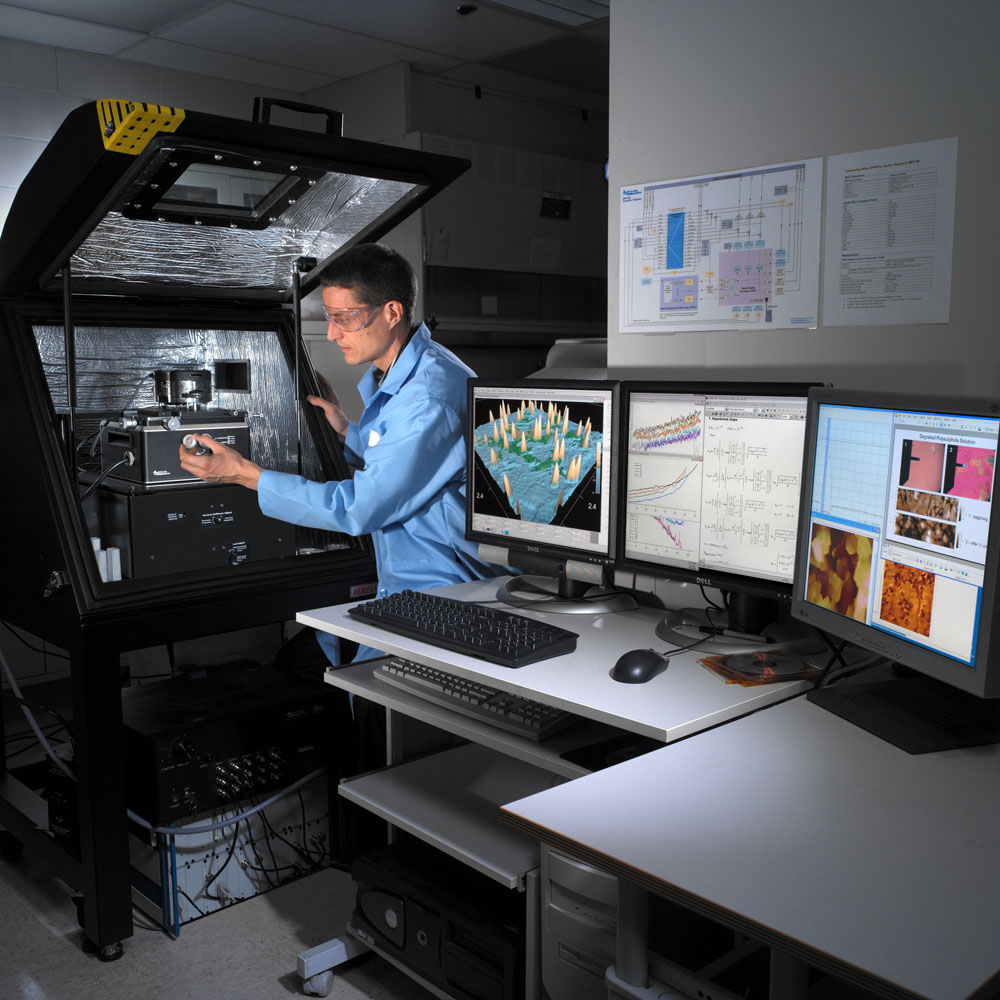
DOWN TO A SCIENCE Arkema uses state-of-the-art sophisticated analytical equipment that yields an understanding of material characteristics on a molecular level. “If you’re working at the molecular level … and you’re trying to convince somebody that you’ve got a change that’s going to bring value … it better be damned compelling,” said Dirkx.
Army AL&T: How much of your product development is developing a completely new product—the “new Kynar,” for example—and how much of it is trying to find different applications for products you’ve already developed? With different applications, do you establish new requirements?
Dirkx: There is a third type of R&D work as well, qualification of our current products in current applications but at new customers, and a fourth, technical service to keep our products running competitively at our current customers. You need to have a balance of these, and each business unit will have a different balance governed more or less by the markets they serve, their current business strategy and the window of opportunity.
But our platforms tend to spawn projects, and the best platforms are those we can draw from to solve a number of problems in the marketplace or with our customers, or to bring value to our customer base. Block copolymers is a good example of that, and I’ll give you another one. We saw, a decade ago or so, this shift in the lighting industry to LED technology. And, of course, next it’s going to go to what’s called “OLED” technology, organic light-emitting diodes. In our Plexiglas division, besides the taillights I mentioned, we have a number of lighting applications. Just like in computer displays, there are a lot of places where there’s an interaction between polymers and light. In particular, Plexiglas often finds use in applications where appearance is really important, this interplay with light. We said, “This is going to be important in LED, it’s important in lots of things we do.” So we built a core competency in understanding how to put additives in the Plexiglas to allow us to manipulate or manage its interaction with light, whether it’s reflection or transmission or diffusion. We’ve developed a whole family of products now that help in the diffusion of LED light—the extraction of light from LED fixtures while hiding the fact that they’re sharp pinpoints of light.
You now see LEDs in taillights of automobiles, in your houses—they’re everywhere, and it’s a high-growth market. So the platform was optics around manipulation of light in Plexiglas. And we find that spawns a lot of products addressing customer opportunities and challenges in the lighting industry, the display industry, the taillight industry and some other industries that would take me a lot more words to describe to you.
Army AL&T: Was there ever something that someone else developed which, after seeing it, you thought you should have been there first?
Dirkx: Yes, of course. We try to be first in areas that are of strategic interest to us but can’t employ the huge resources needed to lead in every area. You have to pick your spots.
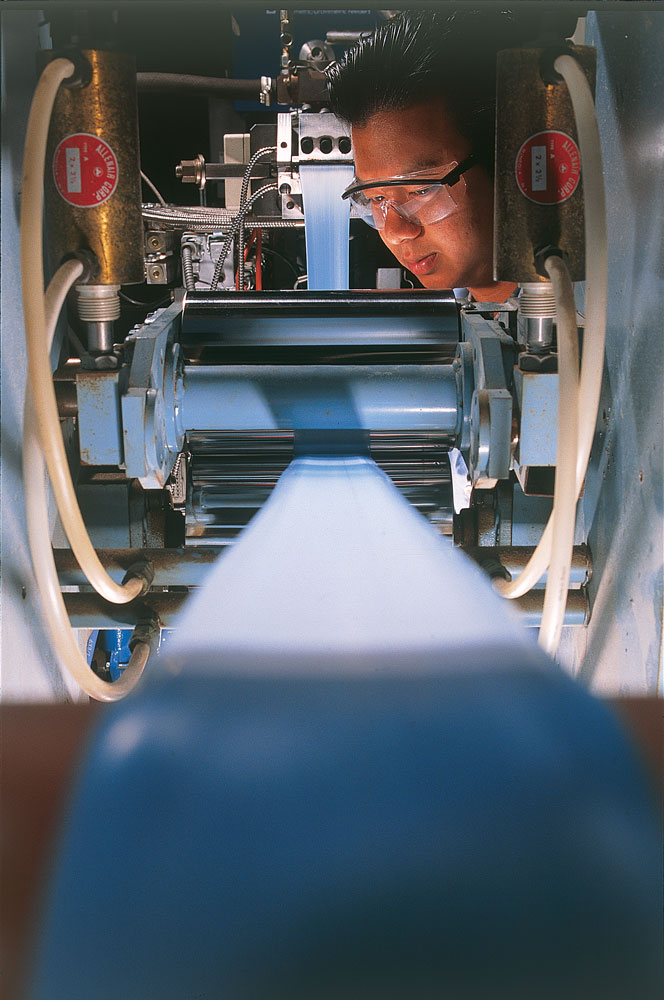
FILM INDUSTRY An Arkema technician tests experimental polymer film. As Dirkx explains it, the company’s technology goes downstream along a supply chain of parts suppliers in a variety of industries. Because of that, the company needs to be able to formulate and make products that their customers might make in order to make sure they can meet customer requirements.
Army AL&T: A lot of people, when they hear the word “chemical,” tend to think of things that are exotic or poisonous. As a chemist, do you tend to look at everything around you as chemical in nature?
Dirkx: Yes, I do. But think of me more as a materials guy, too. I think about it at the atomistic level, I think about it at the materials level. So it’s cellulosic or it’s metallic, or it’s conductive or nonconductive, or it’s porous or it’s solid, or it’s thermally conductive or it’s thermally insulating. But absolutely I do. In fact, I tell my wife that’s why I like to cook. There are a lot of analogies in the materials world when you make stuff by mixing things together. You have something called solid state diffusion, that’s the mixing of flavors, and it’s time and temperature that drives mixing like that. Yes, unfortunately, I do think that way. Think about making your bacon and eggs in the morning. Don’t you get a little different result if you’re using a stainless steel pan rather than a nonstick pan?
Army AL&T: Do you ever experience what we term “requirements creep,” in which something with minimal requirements suddenly has to do and be everything, and so it ends up burdened with expectations?
Dirkx: I’m not sure that we do experience it in the manner you are suggesting. We are often working toward performance specifications or targets rather than “requirements.” These often do “creep” on us, to use your terminology. It’s a competitive world out there, and our competitors are not sitting still!
Army AL&T: Your website has a teaser that talks about “high pressure, low budgets and a short project timeline” in working with a partner company. This is exemplary of what the Army would like to achieve all the time. When you decide to work with a partner, does it make any difference if the partner is a large or small business?
Dirkx: In my opinion, size is not always as important as other things. For example, finding someone who has assets or knowledge complementary to what we have can be more important for project success and acceleration. We also try to pick partners that have some history of working well with others and understand the concept of sharing the value that is created by working together.
Army AL&T: When you find a new application for an existing product that’s outside of Arkema’s regular business lines, what steps do you take next? Would you consider starting a whole new business line if you felt you could address that need more effectively than the competition? If so, what does that process entail?
Dirkx: In this case, if the opportunity is large enough, it will be prioritized as a project and assigned resources. If it is a really new application, then a partner or collaborator is likely going to be needed and a joint-development agreement approach would be considered. However, we could decide to develop our own in-house lab capability if we think it has additional leverage. For something that is really new, requiring a longer-term development period, not a direct fit with an existing business, and offering significant growth, we do have a centralized incubator that we use to develop new technical platforms.
We try to keep our ear very close to our markets, our customer base, and that’s the driver. At the same time, it’s a bit of an art rather than pure science to try to figure out what’s really compelling enough for our customers to drive our activity.

THE BONDING ELEMENT Although Arkema keeps the ability to make polymer foams, such as this one being tested by a technician, it won’t sell the foam directly. It sells the components. “Most often, if you buy an Arkema product, it’s going to be a component of the thing you buy,” said Dirkx. “We’re a very important component because we are—think of it as the glue that holds the whole thing together.”
And we have a new product development process that involves a management process that helps us determine the potential success of a particular project. We think we have way more opportunities than we have people to work on them. So it’s about prioritization as to where we put our resources and what our best bets are.
There can be different opinions inside the company on that. And we have a process for working through that, to figure out how best to make sure that we don’t spend a ton of money on failures—try to fail early, you know.
Army AL&T: What could the Army learn from the way Arkema develops requirements? Or from the way that Arkema conducts R&D?
Dirkx: It is hard for me to say because I don’t have a lot of insight into how the Army does this. There are many studies on market pull versus technical push. My experience says that you need a combination of both. Very often the market doesn’t know what is possible when they’re asked what is needed. If you talk to many of the commercial folks, ideally everything is market pull because they see that as the lowest risk in the marketplace, they’ve got a guy that’s ready to buy.
When you ask your customer what they’re looking for, they’ll answer based on what they think you can bring. For example, I was in business for four years, and during that time I took on some very technical businesses. One was a catalyst business. And I was talking to a polymer guy who used our catalyst to make a polymer. I asked him, “What are your needs, what’s the next great thing we can do for you?”
He said, “Well, when we use this catalyst, the polymer comes out a little bit yellow. We don’t really like that yellow color, and our customers don’t like that yellow color. We’d really rather see it on the blue side.” And I thought, “I think we know how to do that.” We went back to our laboratories, and by adjusting the chemistry we came back in some months—it wasn’t quick because we wanted to demonstrate it ourselves—we put it in their hands and they went through studies and evaluations. And, son of a gun, they got a polymer more on tone toward blue than yellow.
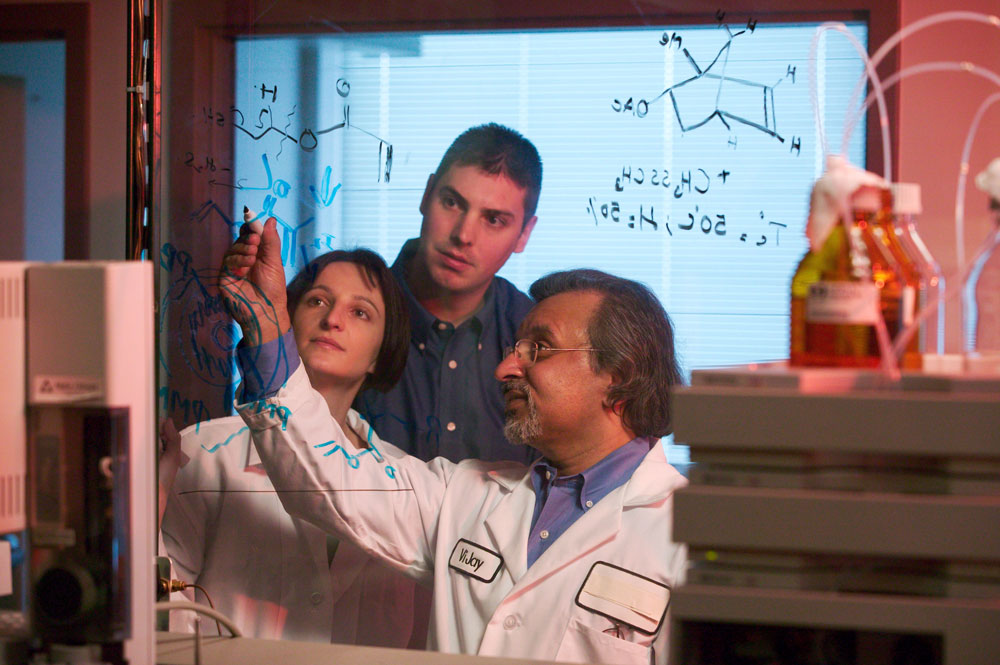
BAND OF SCIENTISTS Arkema’s products include hydrogen peroxide for cleaners, detergents and oral care products, components in lithium ion batteries for cell phones and photovoltaic solar panels, nutrients for chicken feed and polymers for vehicle engines. Ultimately, collaboration and teamwork are a critical part of the company’s R&D success.
They didn’t order a single pound. And I went back and I said, “Excuse me, but this was exactly what you were looking for. I thought we hit it right on the money.” He said, and remember we’re now up the supply chain, “Well, it turns out our customer really wants no color.” And I just spent six or eight months deliberately designing blue because that’s what he said he wanted. I could have spent the time developing no color and probably could have hit that target. His comment to me asking for blue was because he knew that it was probably possible to deliver blue.
That’s a very simplified example. Now think of if you translate to much more complicated systems and questions and multiple suppliers, it can compound the issue. It’s very complex. But it’s a great example of how their question is framed in what they think you can deliver. They look at the hammer you have and they give you an answer based on that. And you can chase your tail. Did we know that we needed a camera in our phone before it was developed?
This article was originally published in the July – September 2015 issue of Army AL&T magazine.
Subscribe to Army AL&T News, the premier online news source for the Acquisition, Logistics, and Technology (AL&T) Workforce.
![]() Subscribe
Subscribe








